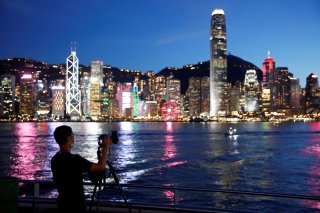Can Hong Kong's Economy Recover from Its Covid Slump?
Hong Kong was one of the last jurisdictions in the world to reopen after COVID-19 at the beginning of 2023.
Hong Kong was one of the last jurisdictions in the world to reopen after COVID-19 at the beginning of 2023. The ensuing economic recovery was short-lived and softer than expected. A mix of both cyclical and structural factors, including international monetary policy and geopolitical tensions, may mean the city never recovers its pre-pandemic shine.
Private consumption in Hong Kong continued to grow through the year but imports and exports remained weak. Capital investment and tourism have also been lackluster. Around nine months after the reopening, visitor arrivals were only 65 percent of their 2018 level. Hong Kong’s asset markets are in similarly difficult positions.
Residential property prices moved up briefly at the beginning of the year but quickly lost steam and declined in the second half, with a year-to-day fall of roughly 5 percent. The Hang Seng Index dropped over 15 percent in 2023 and appears decoupled from the world economy, as the S&P 500 in the United States rose by almost 25 percent the same year.
Hong Kong stocks hit a four-year low in the first half of 2023, with trade averaging just US$14 billion (HKD$116 billion). Funds raised from initial public offerings cratered to a 20-year low in the same period, raising concerns that Hong Kong has lost its luster as an international financial center. It is against this backdrop that the government cut its latest annual GDP forecast from over 4.5 percent to only 3.2 percent.
Hong Kong’s disappointing post-pandemic economic performance was the result of both cyclical and structural factors. On the cyclical side, rising local interest rates following rate hikes by the US Federal Reserve made residential properties an unattractive investment. The strong local currency means that tourists find Hong Kong expensive, while local residents prefer shopping across the border.
On the structural side, Hong Kong is a casualty of geopolitical tensions between the United States and China. Trade sanctions and technology controls have driven down trade shares between the two economies and more goods are now rerouted around Hong Kong through third countries such as Vietnam and Mexico.
Geopolitical tension may have broader impacts beyond trade. Hong Kong long prospered as a gateway to and from mainland China. Financial services, trading and logistics, tourism and professional services have fuelled Hong Kong as an East-meets-West center. Any decoupling from this arrangement may be an existential threat to the city.
A key structural factor is the large disparity in wages and prices between Hong Kong and neighboring Shenzhen. Hong Kong citizens can now enjoy roughly similar services just a short drive away for a fraction of the price. Despite governmental efforts to reinvigorate local businesses, such as the ‘Night Vibes Hong Kong’ campaign, Hong Kong residents will continue to take advantage of cheaper services and goods nearby as their economy more closely integrates with the region.
Demographics pose another structural challenge to Hong Kong. The elderly population is rising while new births are increasingly rare. The fertility rate dropped to 0.77 in 2021, among the lowest recorded rates in the world.
This trend has been accelerated by the outwards migration of Hong Kong’s younger population to foreign countries such as the United Kingdom and Canada, which offer relatively straightforward migration pathways to Hong Kong citizens. The heavy-handed treatment of protestors and the enactment of the national security law in 2020, along with austere COVID-19 restrictions, have persuaded some Hong Kong families to leave. More national security legislation is on the horizon, which will not help the outflow of young workers.
Emigration has shrunk Hong Kong’s labor force. In a survey conducted by the Hong Kong General Chamber of Commerce, 74 percent of participating companies said they faced a talent shortage issue. Companies also complained about increasing labor costs.
The government’s strategy to cope with talent drain and an aging population is to import human resources from mainland China. It has launched different talent schemes to grant easy visas to educated individuals to come to Hong Kong and has approved over 100,000 applications. It’s possible that the program can help address some of Hong Kong’s demographic issues if it continues to attract the same level of interest.
But the city’s broader structural challenges suggest that Hong Kong’s economy will continue to struggle. It also implies that the government may suffer from a structural deficit in the medium term.
With falling property prices and low transaction volumes, the government is set to run a large deficit this year. As the population ages, healthcare and social welfare expenditures will continue to rise.
In his latest policy address, Chief Executive John Lee seemed undeterred by these looming prospects. He proposed pushing ahead with two infrastructure megaprojects, namely the Northern Metropolis and the Kau Yi Chau Artificial Islands, arguing that they would bring about large economic and social benefits.
Given the economic and political uncertainties, as well as their high financing costs, some doubt whether these projects are worth the money.
Vera Yuen is a Lecturer in the Faculty of Business and Economics at the University of Hong Kong.
This article was first published by the East Asia Forum is part of an EAF special feature series on 2023 in review and the year ahead.

